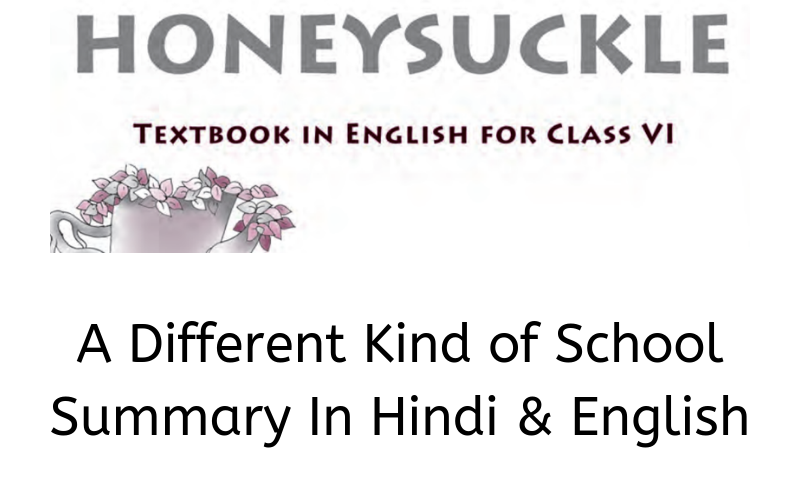
A Different Kind of School Summary In English
This is the story of a school where the children were taught to sympathize with and help each other. The writer had heard a lot about Miss Beam’s School. They said that she was using new methods of teaching to make the children better citizens. The writer wanted to see it all himself. So he had gone to visit Miss Beam’s School. As the author entered the school, he saw a girl whose eyes were covered with a bandage. She was being led carefully between the flower-beds by a little boy.
The author, then, came to Miss Beam who told him that her teaching methods were simple. However, there was only one thing which was different. “The real aim of this school”, she said, “is not so much to teach thought as thoughtfulness and kindness to others”. The author looked out of the window and he was a little pained. He saw that although there were in the open field so many happy children, they were not all so healthy and active looking. He saw two more girls with their eyes bandaged. Then, there was the third with a crutch watching others at play. The author was surprised when Miss Beam told him that the girl with the crutches was not lame. Again, the girls with their eyes bandaged were having no trouble in their eyes. That was an important part of their teaching system.
To make children appreciate and understand misfortune, the school made them share in misfortune. The children are bandaged or made lame so that they understand what this misfortune really is. Then, others are told to help them so that they learn to help those who are in misfortune. So, each term every child had one blind day, one lame day, one deaf day, one injured day and one dumb day. This was the ‘game’ that every child in the school had to play.
Miss Beam led the author to a bandaged girl and left him with her for some time. The author found that the girl appreciated the help she got from others but was determined to be better helper when it would be her chance to do so. She told the writer that the blind day was the hardest. It was so because the movement became difficult. The blind always worried about getting hurt. They would dodge things that were not there. The author led the girl for a short walk. After that short walk, he found that he had already become ten times more thoughtful than before. He also realised the pleasure of describing things and people. These things had become more interesting for him by doing s0.
A Different Kind of School Summary In Hindi
यह एक ऐसे स्कूल की कहानी है जहाँ बच्चों को परस्पर सहानुभूति रखना और एक-दूसरे की सहायता करना सिखाया जाता था। लेखक मिस थीम के स्कूल के विषय में बहुत कुछ सुन चुका था। उसने सुना था कि बच्चों को बेहतर नागरिक बनाने के लिए वह अध्यापन के लिए नये तरीकों का प्रयोग कर रही थी। लेखक, स्वयं उसे देखना चाहता था। अत: वह मिस बीम के स्कूल को देखने गया था। स्कूल के अंदर प्रवेश करते ही लेखक की दृष्टि एक ऐसी लड़की पर पड़ी जिसकी आँखों पर पट्टी बंधी थी। एक छोटा लडका फूलों की क्यारियों के बीच से सावधानी से उसे ले जा रहा था।
फिर लेखक मिस बीम के पास आया जिसने उसे बताया कि उसके पढ़ाने के तरीके सरल थे। केवल एक बात थी जो अलग थी। इस स्कूल का वास्तविक उद्देश्य’, उसने कहा, “बच्चों को विचार देने का उतना नहीं है जितना कि उन्हें स्वयं विचार करना और दूसरों की सहायता करना सिखाना है।” लेगक ने खिड़की के बाहर नजर डाली और उसे यह देखकर कुछ दु:ख हुआ। उसने देखा कि यद्यपि खुले मैदान में बहुत से प्रसन्न बच्चे थे, वे सारे उतने स्वस्थ और गतिशील (ऐक्टिव) नहीं दिख रहे थे। उसे दो और ऐसी लड़कियाँ दिखाई दीं जिनकी आँखों पर पट्टी बंधी थी। वहीं एक तीसरी लड़की बैसाखी लिए अन्य बच्चों को खेलता देख रही थी। लेखक हैरान रह गया जब मिस बीम ने उसे बताया कि वैसाखी लिए लड़की लंगड़ी नहीं थी। जिन लड़कियों की आँख पर पट्टी बंधी थी उनकी आँखों में कोई खराबी नहीं थी। यह तो उनको अध्यापन नीति का महत्वपूर्ण अंग था।
बच्चे दु:ख का सही मूल्यांकन कर सकें और उसे समझ सकें-इसके लिए स्कूल बच्चों को दु:ख बाँटना सिखाता था। बच्चों को पट्टी बाँधी जाती है या उन्हें लंगड़ा किया जाता है ताकि वे समझ सकें कि दु:ख वास्तव में क्या होता है। तब दूसरे बच्चों से ऐसे बच्चों को सहायता करने को कहा जाता है ताकि वे दु:खी लोगों की सहायता करना सीख सक। अत: प्रत्येक टर्म में हर बच्चे को एक दिन अधा, एक दिन लगा. एक दिन बहरा, एक दिन घायल और एक दिन गुण बनना होता था। यह वह खेल था जिसे विद्यालय के हर बों को खेलना पड़ता था।
मिस चीम लेखक को एक पट्टी बंधी लड़की के पास लायीं और लेखक को कुछ देर उसके पास छोड़ दिया। लेखक ने पाया कि वह लड़की दूसरों से मिलने वाली सहायता की कद्र करती थी परंतु उसका निश्चय था कि अपना मौका आने पर वह बेहतर सहायक बनेगी। उसने लेखक को बताया कि अंधे होने वाला दिन सर्वाधिक कठिन था। ऐसा इसलिए था कि चलना-फिरना कठिन हो जाता था। अंधे को हमेशा चोट की चिता सताती थी। वे उन चीजों से बचने का प्रयत्न करते थे जो वहाँ थी ही नहीं। लेखक कुछ देर के लिए लड़की को टहलाने लगा। उस थोड़ी दूर तक टहलने के बाद लेखक को लगा कि वह पहले की तुलना में दस गुना अधिक विचारपूर्ण बन चुका था। उसने यह पाया कि वस्तुओं और व्यक्तियों के बारे में बताना कितना आनंददायक होता है। ऐसा करके वे चीजें उसको अधिक आकर्षक लगने लगी थीं।